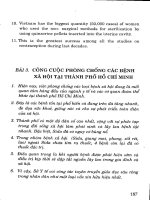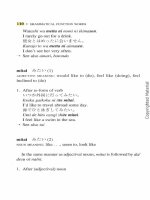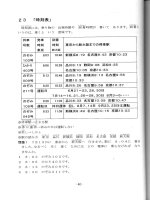Sound Patterns of Spoken English phần 5 docx
Bạn đang xem bản rút gọn của tài liệu. Xem và tải ngay bản đầy đủ của tài liệu tại đây (130.34 KB, 15 trang )
60 Attempts at Phonological Explanation
of their environment with dental/alveolar as a default value, i.e. the
one which is assumed if no other feature takes over. ‘Spreading’
occurs when a feature fills an underspecified slot in an adjacent
unit. Lodge (p. 25) suggests that (2) is true because subsystems
within a language can undergo different processes: onset position
conditions the early specification of place for coronals, whereas
coda position does not.
In addition Lodge also assumes (p. 28) that /Î/ is underspecified
for manner, since it retains its place but can assimilate in manner
to preceding consonants.
3.5.5 Firthian prosodics
Several linguists (Kelly and Local, 1989; Simpson, 1992; Ogden,
1999) advocate an approach which they describe as a develop-
ment from the theories of J. R. Firth (1957). According to these re-
searchers, phonology is done at an abstract (‘algebraic’) level, and
everything else is phonetics. This technique maps directly from
citation form to surface form without attributing any special signifi-
cance to the phoneme or any other abstractly-defined unit. Given a
string of lexical items in citation form, it assigns features to portions
of an utterance, resulting in a nasalized, labialized, or otherwise
phonetically realized section which does not necessarily correspond
to an even number of underlying phonological units. An important
assumption here is that there is no significant structural change in
the spoken form: the citation form is produced or performed using
components which decide its phonetic identity. Some performances
may have little or no acoustic reflex of particular phonological
units as a result of the way the prosodies interact. A useful analogy
might be with stops on an organ which allow the input musical
patterns to be realized in different ways and which can be switched
in and out at independent intervals, even in the middle of a note. (If
these prosodies are thought of as gestures, there is considerable
superficial similarity to the articulatory approach, outlined above.)
The analogy with music fails when it comes to timing: the abstract,
algebraic form is timeless, and duration can be assigned like any
other prosody, so phonology is time-free but phonetics is not. This
means that the timing of phonetic effects can overlap in different
Attempts at Phonological Explanation 61
ways, and this can lead to perceptual impressions such as tap-
ping of alveolar obstruents or epenthetic stops in words such as
‘ham(p)ster’. This approach has been used effectively in speech
synthesis (Coleman, 1994; Dirksen and Coleman, 1994; Local and
Ogden, 1997).
Another major tenet of this theory is that different phonological
systems can exist in different environments/linguistic domains,
so that, e.g. syllable-initial and syllable-final consonants would
not necessarily be expected to show similar phonological behaviour
(as, indeed, they do not), nor would content and function words.
While most processes discussed in this book (for example
devoicing, schwa incorporation, nasal displacement and tapping)
can be accounted for using the Firthian approach, sounds which
appear to be deleted entirely create a problem, as mentioned for
Gestural Phonology, above: if they were really deleted, it would
involve restructuring the input forms, which is not permitted. I say
‘appear to be deleted’ because it would be possible to argue that
the units/gestures are not deleted but simply performed in such a
way that one or more of them has/have no acoustic consequences.
The difference between being deleted and being fully attenuated
must then be made clear.
For more on the Firthian approach, see Langendoen (1968), Lass
(1984, ch. 10), Ogden (1999).
3.5.6 Optimality Theory
Optimality theory (OT) claims that there are certain universal con-
straints which are the raw material for phonologies of all languages.
Like Stampe’s natural processes, they include notions of statistical
frequency: in general, the more common a phonological process is,
the more powerful. Power is expressed in terms of ranking – while
all constraints are violable, higher-ranked constraints are less viol-
able than lower-ranked ones. ‘No Voicing in Final Obstruents’,
for example, is ranked highly in most languages. Languages (or
accents) have different phonologies because rankings are different
from language to language.
OT suggests that there is a language-independent device which
generates all possible pronunciation candidates for a lexical item.
62 Attempts at Phonological Explanation
The language-specific phonological grid (in which the ranking of
the constraints is listed) filters out all candidates but one, the
output.
For a more detailed introduction, see Roca and Johnson, (1999,
ch. 19).
Variation
The major problem in using OT for casual speech phonology is
that while variation across accents can be described, variation within
an accent is (at first glance) impossible to describe because there is
a single mapping between the lexical input and the phonetic out-
put. The ranked constraints determine which of the input forms is
the winner, and there is only one winner.
Kager (1999) suggests two possible solutions: (1) variants are
the result of different phonologies, such that Variant A is generated
by Grid A while Variant B is generated by Grid B. In his words, ‘an
input can be fed into two parallel co-phonologies, giving two
outputs’ (p. 405). This, he admits, is a ponderous solution to a
simple problem. (Nathan (1988) suggests that these co-phonologies
may be styles, such that different speech styles have different pho-
nologies.) (2) Variants are caused by variable ranking of constraints,
such that two constraints can be ranked AB on one occasion
and BA on another. In his words, ‘Evaluation of the candidate set
is split into two subhierarchies, each of which selects an optimal
candidate.’ This is known as free ranking (Prince and Smolensky,
1993).
Kager joins Guy (1997) in preferring the second option; Guy
because Occams Razor argues against such a general duplication of
constructs, Kager because it links the amount of ‘free variation’ in
the (single) grammar with the number of free-ranked constraints.
In the multiphonology option, there is no necessary connection
between the two (or more) grammars needed to generate two or
more outputs from the same input.
In agreement with Anttila (1997), Kager also points out that the
notion of preferred versus unpreferred ranking allows us the possi-
bility of predicting which of the two outputs will be more frequent.
This is a major improvement over the optional rule of generative
Attempts at Phonological Explanation 63
phonology, which we have assumed applied randomly. However,
it is otherwise identical to the optional rule, and the notion of
preferred versus unpreferred application would have made the same
improvement to the older theory. Nathan (1988) points out yet
another problem: there may be three, four, or even more casual
speech outputs from the same input (as demonstrated in Natural
Phonology, above), which makes adequate constraint ranking a
very complex business.
Boersma (1998, ch. 15) carries constraint ranking further in
proposing an OT grammar in which constraints are ranked
probabilistically rather than absolutely. Kager (1999: 407) sums
up this approach: ‘Fine-tuning of free variation may be achieved
by associating a freely-ranked constraint with a numerical index
indicating its relative strength with respect to all other constraints.
This may pave the way to a probabilistic view of constraint inter-
action.’ Boersma claims (p. 330) that the flexibility offered by
such a grammar can shed light on the acquisition of phonology by
children and the ability to understand unfamiliar accents in adults:
listeners learn to match the degree of optionality of their language
environment. This approach is, of course, subject to the same criti-
cisms made of Labov and the Variationists with respect to whether
probabilities are a valid part of grammar.
Glottal stopping in a modified OT framework
In an OT framework, we have a principled way to represent the
fact that different accents of English share casual speech features
but differ in the extent to which these features appear on the surface.
SSB., for example, normally allows glottal stopping of /t / only in
syllable-final position when followed by a consonant or silence.
Some accents allow it intervocalically. Surface forms (such as [cbΈv]
for ‘butter’) are thus included in Cockney and some English
Midland accents. We could say this is because they rank Glottal
Stopping before Unstressed Onset Faithfulness (adherence to the
lexical form at the beginning of unstressed syllables).
Kerswill (personal communication, 2001) reports that there is an
accent in Durham (northern England) in which sequences such as
[syvÚcˆa}mz] ‘seven times’ are legal. Glottal Stopping could thus be
64 Attempts at Phonological Explanation
said to outrank both Stressed and Unstressed Onset Faithfulness in
this accent. There are undoubtedly other accents which constrain
the process in yet other ways.
Following is a proposed phonological grid in the style of OT.
(There is no information here about environments in which the
output can be found or frequency of occurrence of each variant, as
would be called for in an adequate phonological account of the
accents.)
I say ‘in the style of OT’ because the grid has been modified to
allow for variation (indicated by [). A frown (\) indicates that a
form is possible but not preferred, and an exclamation mark (!)
shows that a form is impossible in this accent. Otherwise, the forms
listed are acceptable.
‘Faithfulness’ means that the output matches the input. I assume
here that the constraint which preserves the citation form at the
beginning of stressed syllables is different from the one which per-
forms a similar function for unstressed syllables: we have observed
elsewhere that stressed onsets have a special status.
Moving down from the top of figure 3.1 (SSB.) to the bottom
(Durham), we see that as faithfulness to the lexical form becomes
less constraining, glottal-stopping occurs in more environments,
and variability becomes greater because the ‘faithful’ pronunciation
remains a possibility.
Other casual speech processes such as tapping also lend themselves
nicely to description in an OT framework. Hammond (Archangeli
et al., 1998: 46) describes some aspects of schwa absorption using
OT, but is limited by notions of ‘fast speech’ and by a very small
data set.
3.5.7 A synthesist
One phonetician/phonologist collects, transcribes, and attempts to
provide phonological explanations for casual speech in several dif-
ferent accents of British English and is in the process of developing
a composite phonological theory. Lodge (1984) assumes ‘that Eng-
lish is subject to a number of widespread phonological processes.
Many of these have been recurrent throughout its history and some
have been continuing for a century or more . . . However, these
Attempts at Phonological Explanation 65
SSB.
Stressed onset Unstressed onset Lose oral Other
faithfulness faithfulness closure /t/
‘seven times’
syvvn ta}mz !syvvn ˆa}mz
‘butter’
bÎtv \bΈv
‘cat’
ê kîˆ kît
Cockney, Midlands
Stressed onset Lose oral Unstressed onset Other
faithfulness closure /t/ faithfulness
‘seven times’
syvvn ta}mz !syvvn ˆa}mz
‘butter’
ê bΈv bÎtv
‘cat’
ê kîˆ kît
Durham
Lose oral Stressed onset Unstressed onset Other
closure /t/ faithfulness faithfulness
‘seven times’
ê syvvn ˆa}mz syvvn ta}mz
‘butter’
ê bΈv bÎtv
‘cat’
ê kîˆ kît
Figure 3.1 t-glottalling in several accents
66 Attempts at Phonological Explanation
processes are not distributed uniformly . . . and I hope to show
how the different distribution of the processes helps to distinguish
between the different accents’ (p. 5). He adds, ‘The present book is
intended as a contribution to determine what all English accents do
have in common and what distinguishes them from one another’
(p. 18).
He attributes such processes as lenition, harmony (a wider
term than ‘assimilation’ which incorporates assimilation (including
[v]-assimilation) vowel harmony and palatalization), cluster simpli-
fication, nasal incorporation, glottalling, and glottal reinforcement
to his six accents of British English.
Lodge’s book is couched largely in terms of Dependency Pho-
nology (Anderson and Jones, 1977; Anderson and Ewen, 1980), as
is an earlier paper (1981) in which he makes several provocative
suggestions such as (1) that preconsonantal and prepausal /t / is
underlyingly a glottal gesture (or phonation type) which receives its
surface form from its phonetic environment or, if there is none,
appears on the surface as a glottal stop; and (2) the second element
in some final consonant clusters is more likely than the first to drop
out because the second consonant is dependent on the first but not
vice versa.
Point (1) above is taken up again (1992, 1995) in a discussion
of underspecification. The notion here is that features which are
contextually determined do not have to be specified in deep struc-
ture: features can be copied from surrounding elements, making it
unnecessary to create rules or processes to change fully specified
underlying features. Properties can spread through ‘transparent’
segments without changing them and to underspecified segments.
[Î], for example, has no underlying ‘place’ specification in this
framework because its place varies depending on the previous
consonant.
Lodge uses elements of autosegmental phonology in that tiers
are necessary to relate phonological representations to phonetic
forms, but in later work (1993, 1997) he decides against segment-
level phonology while retaining the tiers. His later work is done in
a declarative framework, using two aspects of the Firthian approach:
polysystematicity (which means that different phonological systems
can be in operation in different parts of a linguistic unit – for
Attempts at Phonological Explanation 67
example, syllable-initially and syllable finally) and the prosody, i.e.
linguistically-significant effects which can be present for a syllable
or more. He gives the example of German ‘bat’ versus ‘Bart’: in
the latter, there is no measurable separate ‘r’ segment – rather,
the whole word is more velarized than the former. (Presumably,
General American ‘hot’ and ‘heart’ would differ in an analogous
way, though the prosody is different.) In this respect, he follows
the Firthian school mentioned above and in fact has written jointly
with this group (Local and Lodge, 1996).
3.6 And into the New Millennium
3.6.1 Trace/Event theory
Until recently, many theories of speech perception assumed that
acoustic input was matched to an invariant lexical representation
through normalization. Variation in the speech signal brought about
by head size, voice type, rate, style, or accent have been thought to
be filtered out or eliminated, allowing the perceiver to arrive at the
more abstract phonological values of the linguistic units.
Researchers have challenged this theory both historically (Semon,
quoted in Goldringer, 1997) and recently (other authors in Johnson
and Mullinix, 1997; Jusczyk, 1997). Their experiments demon-
strate that perceptual tokens which have been heard/seen pre-
viously are easier to perceive than unfamiliar ones. This suggests
that information such as voice type and other features mentioned
above (sometimes called ‘indexical’ information) is stored along
with the linguistic bare bones in the recognition lexicon.
Jusczyk (1997: 206ff) hypothesizes that when a human child
first hears a word, it creates a new entry in its lexicon which is,
limitations of the hearing mechanism aside, acoustic. There are no
linguistic subdivisions or attempts to assign internal structure to
the word, there is no processing which filters out indexical informa-
tion, it is simply stored as a piece of sound with whatever mean-
ing the child is able to assign to it. This acoustic unit is a ‘trace’.
Subsequent hearings of a word recognized as the same are stored in
the same location, so that after some experience with the language,
68 Attempts at Phonological Explanation
each lexical entry consists of a number of traces. Portions of the
lexical item which are consistently present are more highly re-
inforced than portions which are not, so presumably some portions
come to be seen as more essential than others.
This means that variants which we have thought of above as
being linked through some phononological process such as tapping
or vowel devoicing are actually present simultaneously as traces in
the lexical entry and are recognized as the same through having the
same meaning.
Docherty and Foulkes (2000), remark that it would seem highly
uneconomic to assume that the recognition lexicon and the phono-
logical lexicon are different. If traces rather than phonemic-sized
units are the basis of phonological representation, how do phono-
logical constructs such as the phoneme and the syllable and its
subparts emerge in the individual lexicon, if at all? As Shankweiler
and Crain (1986: 42) point out, ‘explicit conscious awareness
of phonemic structures depends on metalinguistic abilities that do
not come free with the acquisition of language.’ Many four- and
five-year-old children with otherwise normal language skills are
unable to count the number of phonemes in a spoken word and
cannot identify words which do not rhyme with other words
(Tunmer and Rohl, 1991: 2). Fowler (1991) suggests, however, that
phoneme awareness grows gradually between the ages of 3 and 7,
and, Mann (1991: 202–4) agrees that a certain amount of pho-
neme awareness develops naturally with age and is found in Japan-
ese nine-year-olds who have not had experience with an alphabetic
writing system. She adds (p. 210) that, counter to Tunmer and
Rohl’s findings, some kindergarten children who cannot read per-
form well on tasks that require the manipulation of phonemes and
can invent spellings that capture the phonetic structure of spoken
words. Earlier work by Lundberg, Olofsson, and Wall (1980) pres-
ages these results.
Presumably, familiar lexical entries are based primarily on acous-
tic information in a very young language user, but are joined by
traces of their written form when the user becomes literate, so
traces can be orthographic as well as auditory. Tunmer and Rohl
also observe (1991: 17) that though some metalinguistic skills in
segmenting words into phonemes is necessary in learning to read,
Attempts at Phonological Explanation 69
the acquisition of reading skills can in turn improve performance
on phonological awareness tasks. So we can assume that traces
from different senses can reinforce each other: evidence for the
opposite certainly exists – ‘what distinguishes . . . the nonreader from
the successful reader is the specific failure to access the phoneme’
(Fowler, 1991: 100). Furthermore, poor readers of all ages show
deficits in naming pictures of familiar objects, suggesting that their
lexical representations are less precisely specified than those of good
readers (p. 101).
The acquisition of letter-to-sound rules can then further allow
new entries to be created by the reader (sometimes in error, leading
to spelling pronunciations such as [cv}k Äuvlz] for [cv}tlz]). These
rules also allow the reading of nonce words and non-words which
presumably do not flourish in the lexicon as a result of lack of
stimulation.
In agreement (however accidental) with Stampe (1979, 1987),
Mann (1991: 207) notes that knowledge of the alphabet is not the
only factor that determines phoneme awareness. Language games
along the lines of ‘pig Latin’ (where a word like ‘bee’ becomes
‘eebay’ with the exchange of the onset and coda and the insertion
of [ei]) are played in a wide range of languages, many of which do
not have alphabetic writing systems. Players include young chil-
dren and illiterates, who could not participate without implicit
knowlege of the phonemic principle in many of her examples. She
adds (p. 209), however, that these games are easier for people who
have acquired an alphabetic system.
One might further propose that phonemic consciousness is a
byproduct of comparing different traces within a location as well
as across locations. If, for example, [bænd] and [bæn] are alterna-
tive pronunciations of the same word, the [d] must be a separable
unit. And if [bænd] and [sænd] are different words, the [b] and the
[s] must be separable items. If so, the phonemic system is a product
of the lexicon rather than the converse.
The fact that traces retain their indexical information and are
not essentially segmental suggests a route for learning to recognize
and produce different speech styles and/or for learning to under-
stand and imitate accents not one’s own: long-term vocal tract
settings could, for example, be represented as traces. (Work by
70 Attempts at Phonological Explanation
Weil (2001) suggests, however, that these long-term settings are
recognizable only in utterances longer than a single word.)
To what degree these powers of abstraction can be attributed to
language users is under debate, but we could easily imagine a com-
plete restructuring of an individual’s mental lexicon upon their
discovering that, say, there is a systematic distinction between ‘p’
and ‘b’ or that ‘ment’ is a suffix. If this were to happen in stages
during the mastery of one’s native language, the lexicon of an ob-
servant and experienced language user could have a form similar to
that of a dictionary, with phonemes, stems, and affixes represented.
Bybee states firmly (2000a: 82) ‘ “Phonemes” do not exist as units
[in the lexicon]; the phenomena that phonemes are intended to
describe are relations of similarity among parts of the phonetic
string.’ She also notes (2000b: 253) that traces do not distinguish
between phonetic and phonological forms. It seems necessary,
however, to have an internal representation consisting of traces
and whatever linguistic constructs have been abstracted in order
to account for the phonemic awareness in children and illiterates
discussed above. People will differ in their ability to make abstrac-
tions from lexical entries, which is likely to be correlated with
differences in reading and spelling ability.
In this approach to describing phonological behaviour the pho-
nemic inventory and the morphology are derived from the lexicon:
small units are products of big units rather than the converse. This
makes any linkage with traditional phonological approaches diffi-
cult, though presumably not impossible.
The trace model is attractive in that it attempts to unite what we
know about human language behaviour with cognitive representa-
tion and in that it can allow for unconditioned variation in a
straightforward manner (cf. Al-Tamimi, 2002). In common with
Gestural and Prosodic Phonology, it also provides a rationale for
the otherwise mysterious fact that native perceivers of a language
recognize reduced sequences as if they were not reduced at all. We
recognize a three-legged dog as still a dog, but with something
missing. One might expect us to have a similar percept of a word
with missing bits, but we recognize the ‘ham’ in ‘hambag’ as a
realization of the word ‘hand’ as if it were fully articulated. In
some sense, the citation form is firmly in the message: the spoken
Attempts at Phonological Explanation 71
version is transparent. Perhaps this is because, as these theories
suggest, full and reduced forms are always simultaneously present
in the minds of the users.
3.7 Summary
Early attempts at describing casual speech used optional rules, which
seem to apply randomly, and variable rules the application of which
is based on sociological variables to account for unconditioned
variation. Some regarded rate and style as the main factor governing
their application. Later work attributes them to vocal tract inertia,
gestural overlap, and/or the non-suppression of natural processes.
Gestural and Prosodic Phonology share the notion that the
underlying representation is not radically restructured by the
articulation process. They are sceptical whether underlying elements
which appear to have no phonetic manifestation actually undergo
a process of deletion or simply cannot be heard, though it is not
clear whether these actually amount to entirely different things.
‘Trace’ or ‘Event’ Theory assumes that our lexical representa-
tions are an accretion of tokens of lexical items which have been
perceived by an individual (presumably in any perceptual mode).
Since this accretion includes all pronunciations, variation of all
sorts is built into the model. More abstract aspects of phonology
such as knowledge of the phonemic system are, however, not
explained. In general, theories which are good at characterizing
abstract phonological systems are not good at characterizing casual
speech processes and vice versa.
Looking back at chapter 2, we must not forget that many of the
conditioning factors for phonological reduction lie in factors out-
side phonology, and the interaction of these factors (morphology,
syntax, semantics, pragmatics, discourse structure) with phonology
must be a concern of anyone interested in explanatory adequacy.
While these interactions (especially that with morphology) have
not been ignored, neither have they been fully explored.
72 Experimental Studies in Casual Speech
4
Experimental Studies in
Casual Speech
Deciding which research can be said to contribute to an understanding
of casual speech is not easy: much of what has been done on speech
anatomy and physiology has contributed to our understanding of the
physical and neurological constraints on the vocal tract which are,
in turn, reflected in casual speech processes. Studies on coarticulation,
stress, syllable production, timing, and rate as well as on general pho-
netic and phonological theory have all provided insights. Much of
the research in speech perception is just as applicable to casual speech
as to other kinds. As we cannot attempt an overview of experimental
phonetics/phonology, this chapter will review research on both speech
production and speech perception by those who have intentionally
investigated casual, unselfconscious speech, with the goal of looking
at what is known about the processes discussed in chapter 2.
4.1 Production of Casual Speech
4.1.1 General production studies
Impressionistic
Some studies of the production of unmonitored speech are based
on impressionistic observation and/or intuition. These generally
consist of phonetic transcription of live or recorded data.
Experimental Studies in Casual Speech 73
Just as it is impossible to list all forebears in experimental lin-
guistics, it would be impossible to list all of the work done on
varieties of spoken English in the sociolinguistic literature, most of
which is impressionistic. Too many descriptions of English accents
to mention here contain information about casual speech reduc-
tions, but combined with more general information on monitored
or citation-form pronunciation. In this work, we take it for granted
that all spoken language is produced under sociolinguistic influences
but do not attempt to quantify these influences, nor can we hope to
survey the massive body of writing on the sociolinguistics of the
many varieties of English.
Brown (1977, 1996) reports having heard a large number of the
processes discussed in chapter 2 in the speech of newscasters. Among
these are schwa absorption, intervocalic weakening of obstruents,
and final t/d deletion. Her book is aimed at teachers of English as
a foreign language, and her message is that students will never
understand English if they are taught only citation forms. (See
chapter 5 for more about her work.)
Lodge’s (1984) summary of processes present in several accents
of British English focuses on informal speech. His conclusions agree
in general with what is said in chapter 2 about [Î]-assimilation,
glottalling, nasal replacement, and palatalization. He attempts to
formulate a phonological framework which can accommodate Eng-
lish casual speech which is discussed briefly in chapter 3 of this book.
Augmented transcription
Another body of research has supplemented phonetic transcription
with acoustic displays, usually spectrograms. Dalby’s (1984) study
of Am. fast speech was aimed at discovering whether unstressed
vowel reduction occurs more frequently as speech rate increases.
He concluded that rate interacts with other factors such as position
in word and number and type of segments adjacent to the unstressed
vowel and proposed a model in which the syllable structure of the
citation form played a large role to account for these complex
interactions.
Shockey’s (1974) dissertation attempts to come to grips with
whether more phonological reduction occurs in unselfconscious
74 Experimental Studies in Casual Speech
casual speech than in speech read from a script. I found that in
Am., while there was some evidence for the notion that read speech
was less reduced, unscripted and scripted speech show very great
phonological similarity: the same processes apply and very nearly
to the same degree. I concluded that the majority of phonological
processes cannot be used as style markers since they are not under
conscious control. Speakers do not know that they are producing
speech which differs from citation form, and, in fact, deny it when
asked. (cf. Brown, 1977: 55). Nolan and Cobb (1994) discovered,
however, that while subjects may not be aware of their own or
others’ casual speech reductions per se, they can make consistent
judgements about the level of casualness in language spoken by
others, suggesting that there are different levels of awareness of
these processes.
I found that using spectrograms as corroboration of one’s pho-
netic transcription is a sobering and enlightening experience, es-
pecially when working with one’s own native language: the phonemic
interpretation of the spoken material emerges as the default percept
if the transcriber’s attention wanders even for a moment. This is
the case even for very experienced phoneticians. Needless to say,
the phonemic interpretation can be unhelpful and even completely
wrong phonetically, and the acoustic displays force the transcriber
to justify each symbol used. The results of my study are reflected in
chapter 2.
Spectrography
Lindblom’s (1990) H&H Theory holds that as speech becomes hypo-
(under) articulated, targets are not realized as fully as in a more
monitored hyper- (over) articulated style, hence there is more
coarticulation between and among segments. A method of testing
this hypothesis was used by Krull. Based on work by Lindblom
(1963) and Sussman (1991), she assumes that formant frequencies
at the CV boundary are affected by the articulation of the con-
sonant, as are F2 (second formant) maxima or minima in the vowel.
She calls the F2 value at the C-V boundary the ‘locus’ and plots
the difference between the locus and the maximal or minimal F2
value of the following vowel (the turning point). If the locus and









